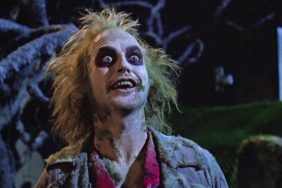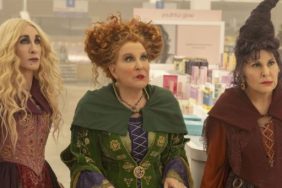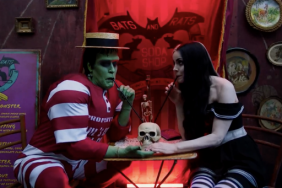Welcome back, my dear students, to another stellar lecture in the ongoing Free Film School here in the ivy-covered halls of CraveOnline. Sit back, grab a snack, and read on. By doing so, you are becoming a smarter and more enlightened human being.
Seeing as it’s October, and the film world is abuzz with all manner of horror films (check your local listings for what horror movies are playing at your local movie theater or art house), I thought I would let this week’s lecture be a brief and fun musing on something I think we all can enjoy: monster movies. More specifically, what makes a good movie monster and what makes a bad movie monster. I’ll be pointing to some good and bad examples, and will spitball a bit on how a movie monster should be filmed. This is not necessarily a very intellectual exercise, this musing on monsters, but it’s certainly fun to ponder, and I think any ambitious young filmmakers interested in starting out in the horror genre would be doing an important practice in thinking about what kind of creature they want rending their cast into pools of red Karo syrup.
What makes a good movie monster? Well, to be perfectly basic right up front, I would say the monster has to look right. Now, to be sure, there are plenty of great horror films wherein the evil malevolent ghosts and monsters remain largely unseen (Val Lewton’s classic Cat People famously never shows the monsters at all, Stanley Kubrick’s The Shining has its ghosts focused through Jack Nicholson’s awesome performance, The Blair Witch Project angered some fans by not showing a money shot of the titular witch), but these are certainly exceptions to movie monster rules. If we are to abide by the old film school adage of “Show, Don’t Tell,” then we’re going to want to eventually show the film’s monster at least once, and, as such, it’s going to have to look nice.

How must it look? Well, a creature is entirely up to your imagination. It can look like something you saw in a movie before, or it can be a totally original monster, but it should look slick, professional, and, most of all, scary. Consider the famous monster in James Whale’s classic Frankenstein, as played by Boris Karloff. It was a totally original design, and the creature rested somewhere between dangerous behemoth, sympathetic loner, and legitimate corpse. The makeup made the creature’s head look misshapen, and putty kept its eyes half closed. It was such an iconic design that riffs on it are still being made today. Heck, just watch Hotel Transylvania. If you’re not down with the 1930s monster films, take a look at the design of the creature in Ridley Scott’s Alien, as designed by Swiss surrealist H.R. Giger. It was, well, alien. It had an elongated head, and no eyes. It was spindly and insectoid. It is such a striking creation that you may not notice how little it appears in the film.
Indeed, I would argue that screentime can actually help a monster. By filming the monster in shadows, and keeping its appearances to brief and terrifying jumps, the creature in Alien is made all the more mythic. True, many fans prefer the up-front and plentiful monster visuals in Aliens, but the 1979 original was much scarier for being less ubiquitous. The same could be said of the creepy-looking sadomasochistic cenobites in 1987’s horror miniclassic Hellraiser. Here were pale-faced beings, dotted with self-mutilating tools (the lead cenobite had nails evenly placed throughout its face and head), who would only appear to offer an intense sexual experience to their hapless victims before dragging them off to a Hell-like realm of otherworldly pain. They only appeared in a few scenes, but we got to know them so well through their absence. What’s more, they had an original and easy-to-understand mythology all their own, so that we could kind of intuit what they were, even if it wasn’t ever made explicit. At least, not in the first of the Hellraiser movies.

Maybe that’s something else to consider: mythology. A monster can look like any old monster, but if you give that monster an interesting enough backstory, it may strike audiences in the right way. I can’t give any practical advice as to what makes a good monster mythology, other than to point to some examples. Edward Cullen is just an ordinary vampire, but teen girls the world over have swooned to his romantic angst and interesting path with his true love. Making a good backstory for the monster might help, although a good origin will work just as well. The monster in the sci-fi classic Forbidden Planet, for instance, was borne of a single human’s ill will and repressed id, manifested through alien technology. Not only does that monster look cool (when we see it electrified; it’s typically invisible), but it has an awesome origin story. We remember the monster better than we remember the characters.

How should a monster be filmed? Well, how you shoot it, of course, depends on what kind of mood you intend to invoke. If you want a spooky monster that is meant to invoke fear, then show less of the monster. Show it in shadows. Don’t let us in on its secrets. It must remain mysterious. If you want to show us the kind of monster with whom we’re supposed to sympathize (like the monster in Frankenstein), you may actually want to show the monster alone, pondering itself, dealing with its own creepy outsider presence. In a late ‘80s film called Nightbreed (incidentally, by the same guy who made Hellraiser), we’re introduced to a species of human-like mutants that live under a cemetery. That film is less about scaring humans, and more about the ins and outs of this mysterious and magical society of creatures. I guess the rule should be this: The more sympathy you want for your monster, the more – and more clearly – you want to film it. If you want the human characters to be victims, and you want sympathy to lie with them, then show the monster less. Keep it hidden. The hunter. We are social beings, we humans, and we naturally want to sympathize with the prey. There’s a reason that the monster in Predator was invisible most of the time.
Another way to make your monster sympathetic: when you design them, make them more human. If you’ve thought of a really cool monster that looks like an inverted squid, and had no eyes, and it eats human bones to survive, it’s likely that audiences won’t relate to it. If, however, the same bone-eater looks like Ron Perlman, then you have a better chance of eliciting sympathy. We can relate to human movements in a creature. We can’t relate to a fleshy cannibal blob. Speaking of which, have you seen The Blob? A living mass of ooze attacks a diner and eats people. There’s no way to feel sympathy for ooze. I didn’t feel bad for a second.

Conversely, if you want your human characters to feel more sympathetic, then make your monsters bigger and meaner, and resemble an animal more. Have them seem more like hunters or takers or killers, beings that cannot be swayed from their task. Think of Michael Myers from Halloween. He is described as pure evil. His humanity is robbed by the expressionless mask he wears, and, indeed, we rarely see his eyes through the eyeholes. He may as well not have a face. He does not speak. We don’t know his motivations. We only know he is driven to murder by some unstoppable compulsion.
This is why I find some many of the recent reboots of horror films to be so offensive. They not only boorishly insert themselves into conversations about the original, but they so often bother to show more backstory of the monster. Hey guys, the monster is only going to be scary if we don’t know what makes it tick, if we know that we can’t say anything to distract it from its task of murdering us. When the psychology is explained, you have a sympathetic monster, and, hence, a less scary one. I don’t need to see young Michael Myers’ home life. I need to see him murdering. His strength comes from how inexplicably he acts.
So, yes, you can over-mechanize your creature. If too much is explained, the monster becomes a set of rules, and not an antagonist. If you explain too much of the way the monster operates, it’ll feel more like a machine with an “off” switch that just needs to be flipped. Look at, well, all the vampires. We know the rules so well (sunlight kills them, for instance, as does holy water) that movies are now employing squirt guns full of holy water and UV lamps to kill them. And while the wholesale slaughter of vampires can be fun (I’m going to do something dangerous and point to the climax of Tales from the Crypt presents: Bordello of Blood), the vampires are scarier when we have trouble killing them. As a result, filmmakers have been re-writing the vampire rules ad infinitum.
This is just personal opinion, but I feel that CGI technology hasn’t advanced enough to make a convincing creature. Oh sure, there are many awesome CGI creatures in movies (Rise of the Planet of the Apes, anyone?), but I fell that nothing can replace the actual physical presence of a monster. Another actor can more readily react to it, and it will have to deal with real gravity. Light hits it in a certain way. In a very general sense, a practical creature will be better than a CGI one. Maybe eventually CGI technology will become convincing enough. But it doesn’t have to go anywhere. We already have expert craftsmen who can make puppets, miniatures and suits to bring creatures to life. I defy you to name a truly scary CGI monster.
An odd question: are killer animals monsters? Like of a lion is wreaking havoc in a mall, or a dog has gone rabid, is it technically a monster? I would say no. I would say killer animal flicks are a mere adjunct of monster movies. Monsters have to be fantastical in some way. Dinosaurs are skirting the line even closer. I’d also say no on dinosaurs as well, though. The dinosaurs in Jurassic Park are giant animals. Godzilla, though, is a monster.

Big knees do not a monster make. Torgo is not a monster.
Anyway, these are just a few fun things to ponder as October unspools, and we take in as many monster movies as we can. Enjoy. Leave some thoughts below. Let’s keep this conversation going.
Homework for the Week:
What is your favorite movie monster? Why is it your favorite? If you were to make a monster movie, what kind of monster would it be? Do you prefer your monsters to be tragic and sympathetic, or evil and animal? What kind of monster works for what kind of movie?






